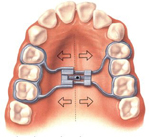Common AppliancesPinehurst, NC
There are many types of orthodontic appliances, and different malocclusions (bite problems) require different solutions. There is typically a single “best solution” for each individual patient, but sometimes there may be multiple approaches.
Whatever the case, to ensure successful completion of your orthodontic treatment plan, it will be imperative that you work closely with Dr. Henry, and follow the instructions that he and the staff give you. The teeth and jaws
can only move toward their corrected positions if you listen closely, act accordingly, and wear your appliance as prescribed.
The following paragraphs offer brief descriptions of some of the more common types of appliances that may be used during your treatment.
Appliances
Separators (or Spacers)
Separators are small rubber bands that are placed between your teeth to push them apart so that orthodontic bands (metal rings) may be placed at your next appointment. Separators are removed before bands are placed. You should not eat sticky foods while separators are in place, and you should not floss in the areas where separators are. Please call our office if a separator becomes dislodged more than one or two days before your appointment.

Elastics (Rubber Bands)
Elastics (rubber bands) are commonly worn during orthodontic treatment. There are varying sizes of elastics, and there are numerous ways that elastics may be hooked onto the braces, depending on what Dr. Henry is attempting to achieve. Generally speaking, elastics are critical aids to help improve the fit of your upper and lower teeth. Wearing elastics consistently, and as prescribed, allows them to be efficient and effective.

Headgear
A headgear may either be used to correct an overbite (standard headgear) or an underbite (reverse-pull headgear). Headgear aims to help Dr. Henry modify a patient’s skeletal growth, and therefore should best be used when a child is actively growing and younger – typically, age 7-11, prior to eruption of the 12-year molars. Consistency is the key to success with headgear, and Dr. Henry generally prefers that you wear the appliance each night, from approximately 7PM to 7AM, so that 12 hours of wear are achieved. Dr. Henry will adjust the headgear periodically, and you should plan on bringing it in to your appointments.

Retainers
Retainers are custom made dental appliances used to keep your teeth in place once your braces are removed. They are also used to treat minor teeth spacing problems. There are two types of retainers fixed (glued in place) or removable. They hold your teeth in their new, correct positions after your teeth have been aligned, and after your bite has been corrected. Dr. Henry will instruct you on how to care for your retainer and about the duration of wear. Wearing your retainer as directed is essential to prevent shifting of your teeth and your bite.

Palatal Expander
The palatal expander “expands” (widens) your upper jaw by putting gentle pressure on your upper molars each time an adjustment is made. Your orthodontist will instruct you about when and how to adjust your expander. When you achieve the desired expansion, you will wear the appliance for several months to solidify the expansion and to prevent relapse.






